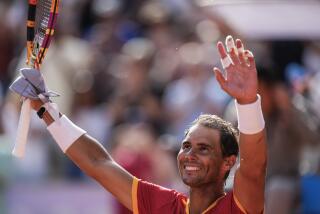For U.S., Questions Go Beyond Surface
- Share via
The U.S. Davis Cup team continues to do well under difficult circumstances. The most recent victory over the Netherlands illustrates how well the American team can do with a less-than-ideal team. It also hints at U.S. mastery of Davis Cup if the top Americans--Pete Sampras and Michael Chang--should make themselves available.
The next round, Sept. 19-21, will be against Australia.
The big question--besides the perennial “Who will play?”--is on which surface? The answer to the first question dictates the answer to the second.
If Sampras plays, and he has suggested he might, the United States probably will choose hard courts. The matches come on the heels of the U.S. Open and players will be accustomed to faster surfaces, which suit them.
If Sampras doesn’t play, the singles players are likely to be Jim Courier, Andre Agassi or Todd Martin, who is recovering from elbow surgery. In that event, clay becomes a possibility. The idea is to try to counter the huge serve-and-volley games of Mark Philippoussis and Pat Rafter of Australia.
If not clay--which would be an abrupt surface change after the summer of hard courts--then slower hard courts are the option.
Once Davis Cup captain Tom Gullikson solves his problems in singles, he can address the one in doubles. The Australians have the best doubles team in the world in Todd Woodbridge and Mark Woodforde--and the United States has whichever team can be scraped together.
U.S. Davis Cup chairman Bo Driskill said no site or surface had been determined but that the matches will be played on the East Coast, from Washington southward.
There is some sentiment to return to Stone Mountain, Ga., where the 1996 Olympic tournament was held, although that sentiment is surely held by USTA officials rather than players.
Australia is the one nation whose Davis Cup history rivals the United States’. The U.S. has won 31 Davis Cup titles, Australia 26.
The Australians, however, have an advantage. The Aussie Davis Cup team gets tremendous support from the Australian public and the country’s Davis Cup veterans.
The plan for the matches against the U.S. team is to bring in Rod Laver, Roy Emerson and Fred Stolle and seat them behind the Australian “bench,” so the American players will see the former champions as they pass by on changeovers.
Powerful symbolism.
DINING AND DANCING
Australia advanced with a 5-0 victory over the Czech Republic at Adelaide. But the mild-mannered Philippoussis and Rafter emerged from the matches not as heroes, but the objects of controversy.
Australia already had taken an insurmountable 3-0 lead on Saturday, and Philippoussis and Rafter went to the official Davis Cup dinner that night, then to a nightclub. Patrons at the club bought the heroes drinks all night. At some point, early Sunday morning, Philippoussis remembered the club DJ coaxing the shy Rafter onto a stage for some solo dancing.
“And Pat can’t dance,” Philippoussis said.
The two made it back to their hotel and got a few hours’ sleep before Davis Cup captain John Newcombe called at 8 a.m. to wake them for their matches.
“I don’t want to play,” Philippoussis said.
“You have to,” Newcombe replied.
“Ugh!,” Philippoussis said.
Knowing his players were not as focused as he would like, Newcombe kept them in the matches by making side bets with them. He wagered Philippoussis that Martin Damm would win more than seven games against him. During the changeover, ahead 5-2 in the second, Philippoussis accepted the $10 Newcombe had fished from his pocket.
Rafter said he didn’t begin to sober up until halfway through the first set against Jiri Novak. Rafter made it tougher on himself by engaging in the longest tiebreaker in Davis Cup history, winning, 15-13.
The antics made front-page news around Australia, but not for the most obvious reason. Some commentators sniffed that Philippoussis and Rafter had not acted as proper role models. But by far the loudest opinion was that the players’ mistake was not in having a night out, but in telling the truth about it.
Newcombe was put in an uncomfortable position, since he was aware of the players’ condition and took no action. What action was he to take? Australia already had advanced, neither player was letting down a teammate, and they both won their matches anyway.
But Newcombe is not one to judge. The whole episode recalled a Newcombe drinking story. Feeling pretty confident with his chances against his unseeded countryman, Mark Edmondson, in the 1976 Australian Open final, Newcombe went out the night before the final and overindulged.
Hung over and sluggish, Newcombe lost the match, marking the last time an unseeded player has won the Australian Open. Like his young charges today, Newcombe was truthful after the match. He admitted that his poor play had something to do with drinking too much of the “tasty brown stuff,” dark Australian beer.
DROP SHOTS
The Toshiba Tennis Classic at San Diego has been rescheduled to the middle of a three-week saturation of professional tournaments in Southern California. First comes the Infiniti Open, the men’s tournament at UCLA, July 21-27. That is followed by the Toshiba, which this year is July 28-Aug. 3. That tournament, voted tournament of the year last season by the WTA players, features Steffi Graf and Martina Hingis. The following week, Aug. 4-10, is the women’s Acura Classic at Manhattan Beach.
The pro-celebrity tournament to benefit the Boys and Girls Club of Orange County is scheduled April 19 at Sunny Hills Racquet Club in Fullerton. . . . The 97th Ojai Valley tournament will get under way April 24 with the NCAA Division III men’s West Regional, the Pacific 10 Conference championships and the women’s Big West championships.



